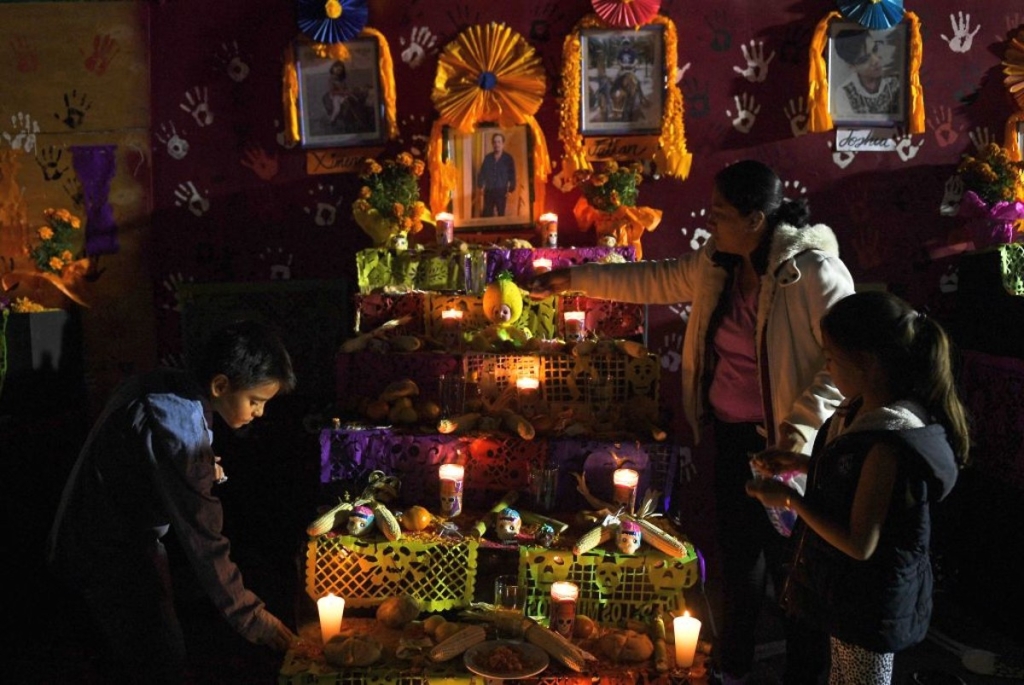( Spanish) — Between November 1 and 2, Mexicans carry out a series of rituals that have their maximum representation in the Day of the Dead offering: altars full of colors, flavors and smells that are placed every year not only in the privacy of homes but also in the offices, hospitals and public squares of the country to honor the memory of those who are no longer here and receive their souls, even if it is only for one night, in the world of the living.
It is a festival, a celebration of death that takes as its starting point the indigenous roots of the indigenous cultures of Mesoamerica, according to historians, to merge with Catholic beliefs and give rise to a festival that continues to evolve over time. weather.
Do you know what the offerings are like and what elements make them up?
The Day of the Dead offering, according to the National Institute of Indigenous Peoples (Inpi) of Mexico, is part of a ritual in which the intention is “to be close to our dead to dialogue with their memory, with their life.”
And to remember them and receive them on their return to the earthly world to share with the living, according to the customs of the Mexican population, altars full of colors, flavors and smells are set up: cempasuchil flowers, sugar and chocolate skulls, bread of the dead, water, candles, fruit, wine, mole and all the favorite food and drink of our ancestors.
This is nothing more than the reflection of the syncretism between two cultures: the worldview of indigenous peoples and the religious beliefs of Catholicism.
“The Europeans put some flowers, waxes, candles and candlesticks; the indigenous people added the incense with their copal and the food and the cempasúchil flower (Zempoalxóchitl),” says Inpi.
The historian Héctor Zarauz, author of the book “La fiesta de la Muerte”, highlights other elements that were added during the conquest.
“The crosses, which are representations of Catholicism, or some drinks that are added to the offering for the dead, distilled beverages that did not exist before. Neither is what is very traditional today, the bread of the dead, since then there was no flour,” Zarauz told .
Between cempasúchil, sugar skulls and chopped paper: the elements that make up the Day of the Dead offering
(Credit: PEDRO PARDO/AFP via Getty Images)
The Day of the Dead offering can vary depending on the region of the country in which we find ourselves, but there are a series of elements that are essential and that you will find in most altars, which are usually organized by multiple levels that symbolize the path traveled by the dead.
There are two levels that represent heaven and earth. Then there are those of three that represent heaven, earth and the underworld. Finally, the one with seven levels symbolizes the seven steps that the soul has to go through to enter the afterlife, according to Mexican beliefs.
The altars or offerings are placed, according to tradition, from October 31 and are ready to receive loved ones at dawn on November 1 and 2, the main days of this celebration. The first one remembers deceased children and the second one adults.
These are the essential elements of an offering or altar of the dead:
Water: the offerings usually wink at the four elements of nature, including water that symbolizes purity and is offered to souls to quench their thirst after the long journey.
The salt: It is the element of purification, it serves so that the body does not become corrupted, on its round trip for the following year.
Candles and candles: In pre-Hispanic Mexico, slices of ocote were used. At present, the candle is used in its different forms: candles, candlesticks or waxes. The flame they produce means “light”, faith, hope and serves as a guide so that the souls can reach their old places and illuminate the return to their home.
Copal, incense and ash cross: For the indigenous people, copal was an element of prayer and praise to the gods, while incense was incorporated with the arrival of the Spaniards. They are used to clean the place in case evil spirits are around. The cross of ashes serves so that the soul reaches the altar and can expiate its pending sins.
Cempasuchil flowers: Tradition says that it is through the orange color of this flower that the souls of those who have departed find their way back to the world of the living.
Food, drink and bread of the dead: The food has the objective of delighting the dead who visit the offering, so their favorite dishes are always placed. For adults, alcoholic beverages are usually served — rum or tequila are common — that will make them remember their happy moments. While the children are offered typical sweets.
The bread of the dead is included as the “body of Christ”, according to Catholic beliefs, and the chocolate that in the pre-Hispanic tradition was prepared with the water used by the soul to wash, thus impregnating the essence of the deceased.
Sugar skulls: the medium ones remind that death is always present; the small ones are dedicated to the Holy Trinity and the big ones to the “Eternal Father”. Mesoamerican cultures took the skulls of sacrificed prisoners and formed them in a row to honor the gods, the altar was called tzompantli. The skulls allude to that pre-Hispanic tradition.
Shredded paper and petate: papel picado is commonly used to represent the air, in addition to giving a festive touch. The petate is used for the dead to rest and can function as a tablecloth to place the elements.
The pictures: the photos of loved ones who have already died are one of the central elements in the altar of the dead because they show who the offering is dedicated to.
The izcuintle: The izcuintle is a pre-Hispanic puppy whose figure is offered in the altars dedicated to children as a toy so that the souls of the little ones are happy when they arrive at the banquet. The izcuintle puppy is the one that helps souls cross the mighty Chiconauhuapan River, which is the last step to reach Mictlán, the underworld for the Mexicas.
With information from Krupskaia Alis





![[Img #74683]](https://thelatestnews.world/wp-content/uploads/2024/12/The-main-mistakes-to-avoid-when-betting-on-electronic-sports-150x150.jpg)









